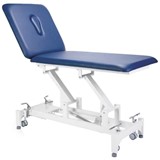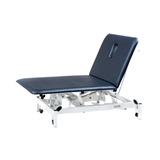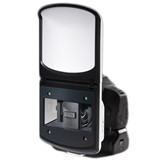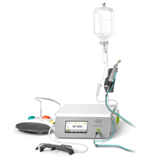Electric treatment tables are an excellent option for permanent treatment rooms. They support ergonomic practices, allowing practitioners to work comfortably and reducing strain. The adjustable height settings make it easier for patients to get on and off the table. While these tables offer flexibility and convenience, paying close attention to safety is essential due to their moving parts and electrical components. This article will highlight the critical safety considerations to ensure the well-being of both patients and staff.
Safety and Stability Considerations
Here are four technologies to consider in an electric treatment table:
Structural integrity
The stability of a treatment table is crucial because any instability can lead to dangerous situations, such as patient falls or injuries to practitioners. To avoid these risks, look for a table with a solid locking mechanism that secures it during treatments, ensuring it remains stable even when subjected to dynamic movements or pressure.
Dual Locking Castors Technology
The inclusion of dual-locking castors can enhance both stability and mobility. These castors allow the table to be easily moved when needed but locked securely in place during procedures, preventing any unwanted movement.
Adjustable Levelling Legs
Adjustable levelling legs are another crucial feature to consider. They allow the table to maintain a stable and secure surface for all procedures. This adjustability is essential for ensuring the table’s stability in various environments.
Rounded Frame Legs
The design of the table’s legs plays a significant role in safety. Rounded frame legs minimise the risk of injury, particularly in confined or high-traffic areas where sharp corners could pose a hazard. This thoughtful design detail helps protect both practitioners and patients in busy clinical settings.
Essential Accessories for Safety
Treatment tables must be equipped with essential safety accessories to ensure a safe and comfortable experience for patients. These components are designed to enhance stability, support, and hygiene. Here’s a look at the key accessories that contribute to a safer and more comfortable treatment environment.
Face Hole and Plug
A face hole with a plug ensures comfort and proper alignment during face-down procedures like massages. The plug keeps the surface level when the face hole isn't used.
Adjustable Armrests
These armrests offer vital support, reducing the risk of falls and discomfort. They can be adjusted to fit different patients and treatment needs.
AntiMicrobial Upholstery
High-quality anti-microbial upholstery minimises infection risk by resisting bacteria and other pathogens, keeping the treatment environment clean and safe.
Safety Padding
Thick, high-density foam padding protects patients from injury during treatments, providing consistent cushioning and support.
Quality Indicators in Treatment Tables
To assess the quality of an electric treatment table, focus on three main areas:
Tables Quality
The quality of an electric treatment table is vital for keeping it safe and lasting a long time. When the table is made, the way it’s built shows how good it is. A strong, well-made table should stay steady and not tip over, even if you put pressure on the edges or sides.
Motor and Component Quality
A good motor that's well-tested and dependable is less likely to break down or cause problems. How the table is built also affects its safety and duration. For example, if screws are placed correctly and if the frame moves smoothly on bolts or bearings, it makes the table safer and more long-lasting.
Service and Support
A good-quality treatment table should come with reliable customer service. This means that if any problems come up, the service team should be quick to fix them. This helps keep the table safe and working correctly.
Importance of Proper Sizing - Measuring for the Right Table Size
A properly sized table allows easy movement and reduces the risk of strain or injury. The right size means practitioners can reach the patient comfortably without repositioning them often. Also, ensure the table fits in the treatment area and does not disrupt movement or workflow.
Impact on Ergonomics
Remember to measure the space for the table, including clearance for movement and potential obstructions. Ensure the table is large enough for patients of various sizes and has adjustable components. Choose a table height that aligns with the practitioner's working height and allows easy access from all sides.
Customisation Options
Many treatment tables can be customised with adjustable heights, tilts, and sections to meet specific needs. Users can choose materials and finishes based on durability, patient comfort, and aesthetic preferences.
Maintenance and Servicing
Regular maintenance is critical to the long-term safety and performance of electric treatment tables. Here are things to consider:
Annual Servicing
Annual servicing is recommended to check for issues like metal fatigue, loose screws or bolts, and exposed electrical cables—these can cause severe accidents if not fixed. Proper electrical tagging is also crucial to ensure the table meets safety standards and regulations.
Routine Maintenance Tips:
Routine maintenance should include periodic cleaning and lubrication of moving parts, following the manufacturer's guidelines. This will help extend the table's lifespan and ensure it functions smoothly. It is recommended that professional help be sought for thorough inspections to prevent significant safety issues.
Staff Training and Safety Protocol
Even the best equipment can be dangerous if not used correctly. That's why it's essential for all staff members to receive thorough training. This training ensures everyone knows how to use the table safely, perform basic maintenance, and what to do in an emergency.
So, It's necessary to have clear safety rules for everyday use. These rules should cover everything from using control panels and foot pedals correctly to what to do in case something goes wrong. Regular training on these rules can help prevent accidents and make sure everyone knows the latest safety practices.
In conclusion, safety is the most important consideration when using electric treatment tables. It involves more than just choosing a high-quality product. Factors such as stability, correct use of accessories, attention to material quality, proper sizing, regular maintenance, and thorough staff training are all critical for creating a safe and effective treatment environment. By considering these aspects, you can guarantee that your practice meets and surpasses safety standards, ensuring the best care possible for your patients.
Ready to invest in the best electric treatment table for your facility?
- Compare features, prices, and specifications to find the right fit.
- Take into account the ongoing costs of maintenance and consumables.
- Check supplier credibility through reviews to ensure reliability.
Get quotes for treatment tables now!
FAQ
Q: Why is the quality of a treatment table important?
A: The quality of a treatment table is crucial because it directly affects the safety, durability, and overall performance of the table. A high-quality table ensures stability during treatments, reduces the risk of accidents, and provides a long-lasting solution that withstands frequent use in medical and therapeutic settings.
Q: What materials should I look for in a high-quality treatment table?
A: Look for treatment tables made from strong, durable materials such as thick steel for the frame and high-quality upholstery for the table surface. These materials contribute to the table’s structural integrity and longevity, ensuring it can safely support patients of various sizes and withstand the demands of daily use.

.jpg)























(1)-205x205.jpg)